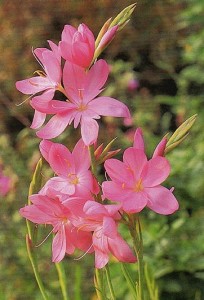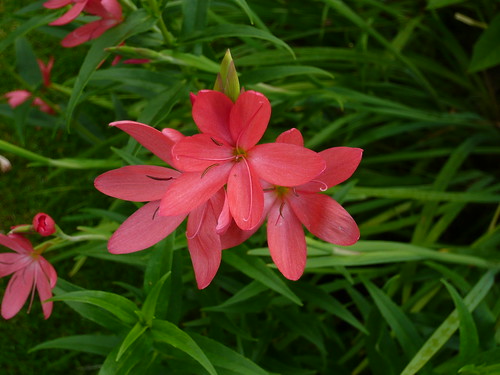Schizostylis coccinea – aka Hesperatha
Watered well during the year and you will get a good autumn show after other lilies have long gone.

Schizostylis are good Autumn flowers lasting through autumn into November.
I like the pencil thin, sword like leaves and the proud spikes of flower opening in clusters up the stem.
Gardeners Tips for Kaffir Lilies
Schizostylis need moist soil from spring through summer to give a good Autumn show.
Grow and allow to develop in clusters for a good display and appealing effect.
The more Autumn sun they receive the better the display.
Propagate by division of the rhizomes in late winter.
I do not feed my plants but ensure there is always plenty of moisture around in the soil.
Grow away from the edge of borders as they all tend to tumble forward
Looks good with purple Asters
Mulch in spring after rain will a layer of gravel
Variety and other Names
Schizostylis can flower in white, pinks and dark red. Schizostylis coccinea ‘Jennifer’ is the most common pink form and Schizostylis coccinea Major is a deep blood red.
Now horticulturally classed as Hesperatha coccinea Major
November Cheer and Viscountess Byng are named varieties of other late flowering varieties and there are many other names used by nurseries.
Kaffir lily has strong negative connotations as Kaffir is a derogatory name used by some for black South Africans.
Ken Thompson has provided some of the updated information below and he has some suggestions for alternative common names. Cape lily, crimson flag lily or river lily are already used in some circles but it will be a long time before I drop Schizostylis because I enjoy saying it!
New Botanic Name since 2012
The original of this post was written in spring 2008. This section now updates the botanic information.
Scientists have proven to their satisfaction, using DNA techniques, that Schizostylis coccinea is identical to Hesperantha and that the two plants are in-fact the same.
Henceforth the official designation of Schizostylis coccinea will be Hesperantha coccinea.
Unlike other Hesperantha this form will grow from rhizomes (that love damp soil).
There are 80 species of Hesperantha mostly corm based, pink flowering plants.

2 thoughts on “Schizostylis coccinea – aka Hesperatha”
Comments are closed.